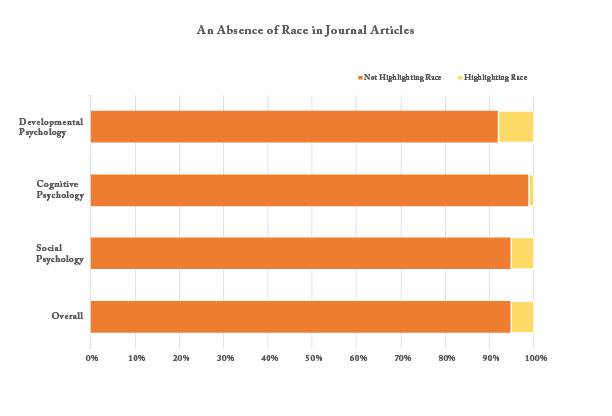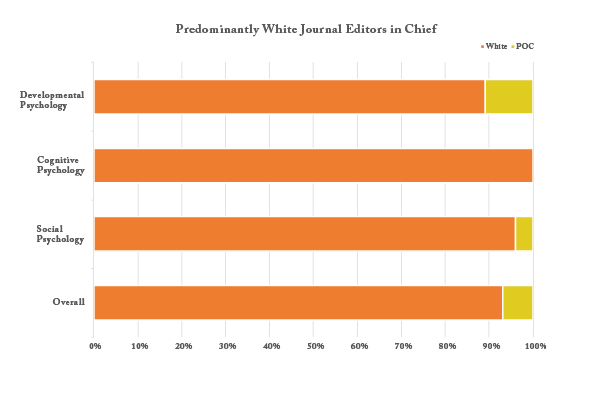Featured
Turning the Page: Race in Research and Publishing

Psychological scientists have deeply studied bias, exploring explicit and implicit attitudes, stereotypes, just-world beliefs, motivated cognition, and structural inequality. Less thoroughly researched, however, is the impact of these biases and structural inequalities on the scientific process itself.
“Clinical psychology is an incredibly diverse field, but this diversity has been remarkably absent in the editorial teams leading our top outlets. This results in a highly restricted pipeline influencing which papers are ultimately published and subsequently shape the field in consequential ways”
APS Fellow Jennifer Tackett (Northwestern University)
In a 2020 article published in Perspectives on Psychological Science, Steven O. Roberts, Carmelle Bareket-Shavit, Forrest A. Dollins, Peter D. Goldie, and Elizabeth Mortenson (Stanford University) analyzed the role of race in psychological science publications. Examining more than 26,000 empirical articles published between 1974 and 2018 in six top-tier cognitive, developmental, and social psychology journals, they found that “the psychological publication process is no less reflective of racial inequality than most of society.” Neither the quality of the research nor the quantity of researchers of color could explain why many of the most prestigious psychological publications on race have been published by White psychologists.

Among Roberts and colleagues’ specific findings, only 5% of the articles highlighted race in their title or abstract, including:
- fewer than 1% of the cognitive psychology articles
(14 of 3,689), - 8% of the developmental psychology articles
(878 of 11,123), and
- 5% of the social psychology articles (619 of 11,568).
In total, the six journals had 60 unique editors in chief between 1974 and 2018. Of these, 83% were White, 5% were people of color, and 12% were not identified. Among the articles that highlighted race, 87% were edited by White editors in chief (1,119 of 1,284), including:
- 100% of the cognitive psychology articles (14 of 14),
84% of the developmental psychology articles
(707 of 837), and
- 92% of the social psychology articles (387 of 433).
Among the 1,745 unique editorial board members
coded in the analysis:
- 76% were White,
- 10% were people of color, and
- 14% were unidentified.
Additionally, the race of a journal’s editor in chief (who often invites the journal’s editors) seemed to predict the racial diversity of the editorial board. When editors in chief were White, 6% of editorial board members were people of color; when editors in chief were people of color, that proportion jumped to 17%.

Roberts and colleagues also found that fewer publications highlighting race had been accepted and published by White editors than by editors of color. They offered two possible explanations: “(a) White editors are less concerned or familiar with race, or (b) authors who study race may be more likely to submit their work to editors of color at specialty journals.” On either account, the authors argue that those in control of the publication process are structurally related to what does (and doesn’t) get published.
Roberts and colleagues also analyzed the 1,093 unique first authors in a selection of articles about race. They found that 63% were White and only 23% were people of color.
Finally, Roberts and colleagues looked at research participants. Across all of the articles that highlighted race, 42% of participants were White, 48% were people of color, and 10% did not report their race. White participants predominated in publications written by White authors (52% of participants) but not in publications written by authors of color (35% of participants).
Related content from this issue:
- An Uneven Playing Field: Women in the field have come so far—and have some distance yet to go.
- From Words to Action: Higher education shifts gears in taking on diversity, equity, and inclusion
- The Bias of Crowds: How social environments change our minds
- Up-and-Coming Voices: Previews of emerging research on inclusivity
Increasing representation in psychological science publishing
Roberts and colleagues recommended that publishers adopt the following explicit and transparent measures to help improve diversity, equity, and inclusion in research and publishing:
- Communicate a top-down commitment to diversity.
- Include diverse individuals across all levels of the publication process (i.e., editors, reviewers, authors, and participants).
- Merit participant diversity in the review process (e.g., create badges for publications that do not concern Western, educated, industrialized, rich, and democratic [WEIRD] samples).
- Release public diversity reports annually.
- Establish a diversity task force.
For authors, they recommended practices that increase transparency regarding the racial distribution of recruited participants, allow for a better understanding of results, and encourage caution in making assumptions about the applicability of results to diverse samples:
- Detail the racial demographics of samples.
- Justify the racial demographics of samples.
- Include constraints on generality statements (i.e., if a sample is homogeneous, discuss the implications for the generalizability of findings).
- Include positionality statements (e.g., explain how the identities of the authors relate to the research topic and to the identity of the participants).
These recommendations should not be limited to race, Roberts and colleagues noted, given that “intersectionality is also vital to a healthy and representative science (e.g., persons representing a wide range of gender, political, religious, and sexuality).”
In addition to adopting the measures proposed by Roberts and colleagues, publishers can take other steps to improve inclusion throughout the peer-review process.
To address reviewers’ biases regarding gender, race, geography, seniority, and institutional affiliation, APS Fellow Rob Goldstone (Indiana University), editor of Current Directions in Psychological Science, suggested in an email to the Observer “actively pushing to make editors and reviewers blind to the identity and affiliation of authors in increasingly many publishing contexts.” For instance, top-tier journals in psychological science usually identify authors to reviewers, but reviewers have the choice of whether to identify themselves. In many other disciplines, however, the peer-review process is double-blind (i.e., reviewers are anonymous and the author’s identity is unknown to the reviewers) or even triple-blind (i.e., reviewers are anonymous and the author’s identity is unknown to both the reviewers and the editor).
The way the peer-review process has been handled in psychological science is “frustratingly ironic,” Goldstone added, “given that it is psychologists themselves who have convincingly demonstrated that people continue to show biases even when they believe that they are being fair and unbiased!”
Another way to increase equity in psychological science publishing is to ensure that editorial teams represent different demographics, geographic locations, cultures, experiences, and expertise. APS Fellow Jennifer Tackett (Northwestern University), recently appointed editor of Clinical Psychological Science, reflected on her efforts to ensure diverse representation while assembling her associate editorial team: “Clinical psychology is an incredibly diverse field, but this diversity has been remarkably absent in the editorial teams leading our top outlets. This results in a highly restricted pipeline influencing which papers are ultimately published and subsequently shape the field in consequential ways. It is long overdue for our top outlets to better reflect the wide diversity existing in the field itself, which will in turn result in greater diversity and intellectual expansion in the papers appearing in our journals.”
Tackett addressed various forms of diversity, including age and institutional diversity. “Clinical psychology, like other areas in psychology, has been long dominated by very senior scholars, often clustering at elite institutions. This, too, results in a stifled and biased academic pipeline, missing the amazing scientific contributions to the publication process that we might find with broader institutional participation and the explicit prioritization of younger scholars.”
Feedback on this article? Email [email protected] or scroll down to comment.
Reference
Roberts, S. O., Bareket-Shavit, C., Dollins, F. A., Goldie, P. D., & Mortenson, E. (2020). Racial inequality in psychological research: Trends of the past and recommendations for the future. Perspectives on Psychological Science, 15(6), 1295–1309. https://doi.org/10.1177/1745691620927709





APS regularly opens certain online articles for discussion on our website. Effective February 2021, you must be a logged-in APS member to post comments. By posting a comment, you agree to our Community Guidelines and the display of your profile information, including your name and affiliation. Any opinions, findings, conclusions, or recommendations present in article comments are those of the writers and do not necessarily reflect the views of APS or the article’s author. For more information, please see our Community Guidelines.
Please login with your APS account to comment.